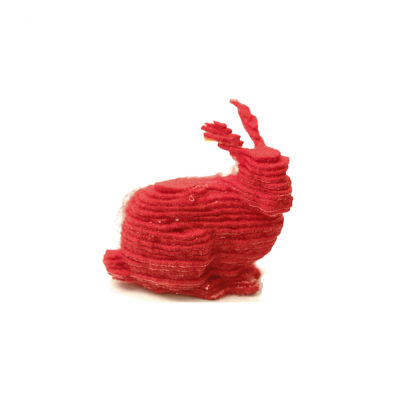CHI Preview: HCII Researchers Unveil 3D Fabric Printing Technique

Mention 3D printing, and most people will conjure up images of rough plastic items with hard surfaces and sharp angles. Warm and fuzzy doesn't often enter into the picture. But a team of researchers from Cornell, Carnegie Mellon and Disney Research has developed a 3D printing technology that might change that forever. Plus they're making those objects interactive.
Working with Huaishu Peng from Cornell University and James McCann at Disney Research, HCII faculty members Jen Mankoff and Scott Hudson have created a 3D printing technique that results in a flexible, soft-to-the-touch 3D object that users can also interact with. The researchers will present their work at the Association for Computing Machinery's Computer-Human Interaction (CHI) conference next week in Seoul, South Korea. The paper, "A Layered Fabric 3D Printer for Soft Interactive Objects," earned one of the conference's Honorable Mention awards.
The printing technology the team developed uses layered fabrication that builds objects from sheets of material — in this case, fabric. A laser cutter trims the fabric to the correct shape, and each layer is bonded to the previous layer with heat-sensitive adhesive. While the printer cuts each layer, the fabric surrounding it is temporarily kept intact to prevent damage to the final product. As the layers mount, the object takes shape inside a rectangular prism made from of fabric. When the printing is complete, the prism is carefully trimmed away to reveal the object.
This printing technology is made possible in large part by the printer itself. The researchers developed a system that differs from other 3D printers in that a vacuum holds the material in place above the laser cutter. As each layer is completed, a bonding platform at the base of the printer rises and the vacuum is turned off, releasing a new layer that joins the stack of layers on the platform. The bonding platform is then lowered and a heating disc bonds the cut layer to the previous layers. Finally, more fabric is threaded through the top of the printer to prepare for the next layer. In just two hours, the printer can create something soft and fuzzy (like the bunny pictured at right).
Because the printer accommodates two separate fabric feeds in a single print, the researchers could also produce 3D objects with variations, like doll clothes with designs on them or an object that exhibits a draping effect. The dual feeds also allow the researchers to create soft interactive devices by using a conductive fabric as one of the materials. The researchers created a touch sensor shaped like a starfish, and objects with printed "wiring," like an LED display that uses a conductive fabric coil for wireless power reception.
"Although we have far to go, we hope to eventually use this technology to fabricate a range of soft devices," Hudson said. "Things like TV remote controls or fitness monitors that are currently in a hard shell might eventually be soft and flexible. This could make them fit better on the couch, or allow them to become part of the clothes we wear."
Read the full paper here, or check out an article about the research on phys.org. Learn more about CHI2015 here.

